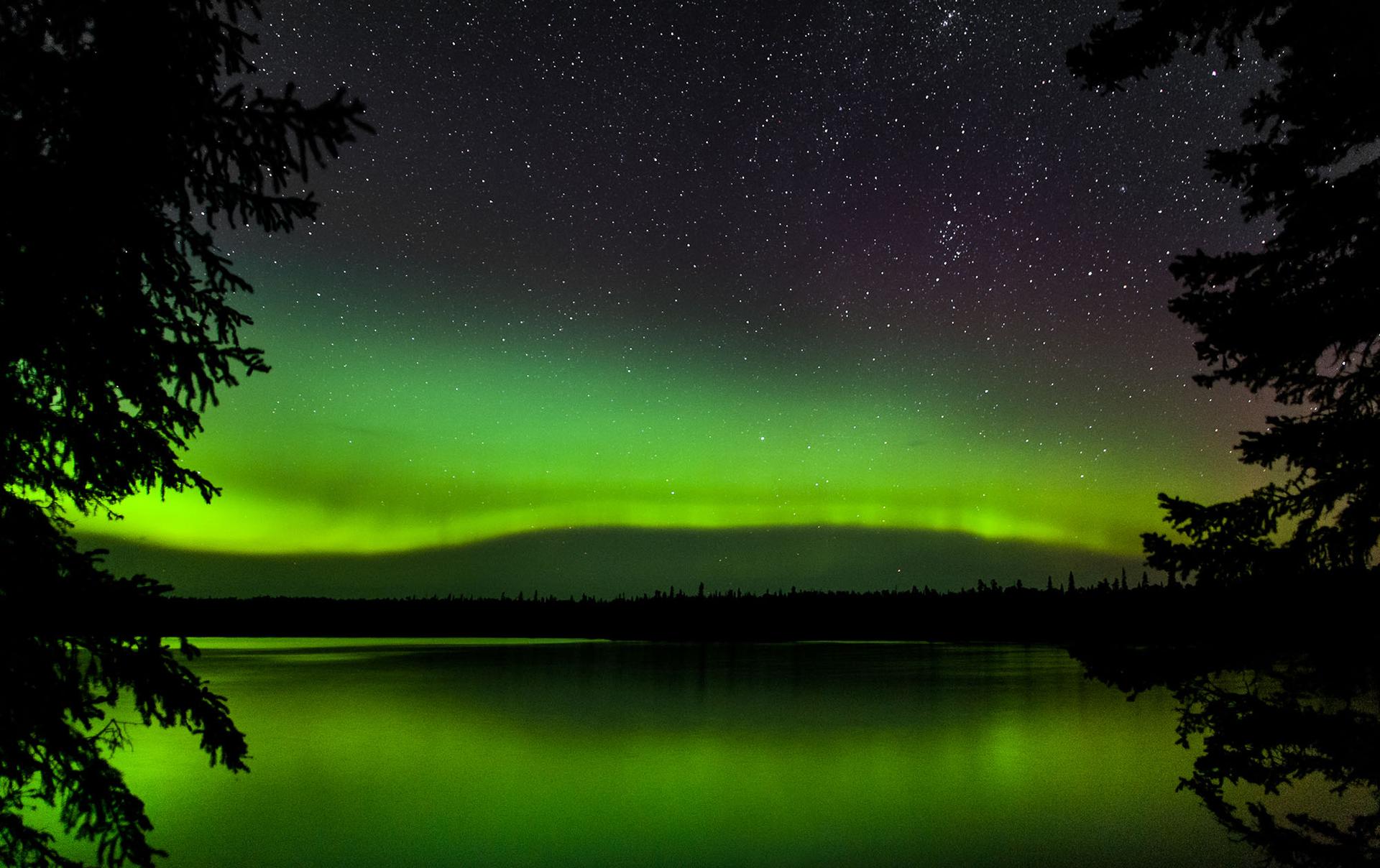Where to see the northern lights in Ontario

Canada is one of the best places on the planet to see the Northern Lights and Ontario, in the country's east, is no exception. Here's your guide to where and when to see the best aurora borealis shows. No matter where you are, it's sure to be a thrill.
When to see the lights
It's true, you're more likely to see the effect further north and in the Arctic, but you can still catch the elusive aurora regularly in Canada's lower latitudes, and that includes Ontario. The Northern Lights, or aurora borealis, is a natural phenomenon in the Northern Hemisphere occurring when the sun's electrically charged particles enter Earth's atmosphere on a solar wind and collide with oxygen and nitrogen gases producing an eerie green glow, misty wisps or curtains of light, or a dancing array of colours zigging and zagging across the night sky. Much of Canada's North lies beneath the Auroral Oval, a magnet of activity.
Chilly winter nights are your best bet and late is optimal -- usually around midnight (11 pm to 3 am). Fall and winter mean longer, darker days and cold nights usually offering the best conditions for a show. For Ontario, September and October are prime time.
Aurora hot spots
You need to be somewhere outside the city, obviously, with little ambient light for the best conditions to see a dramatic aurora display. For example, top spots include backcountry camping or at an off-the-grid wilderness lodge. And you want to go as far north as possible to up your chances. In Ontario, the best places are:
- Manitoulin Island: This natural wonder is the only Dark Sky Preserve in northern Ontario and has some of the province's inkiest skies. Plus, Manitoulin is magical, a far off the beaten path island in Lake Huron that feels lost in time with a slow-lane pace and authentic Aboriginal culture.
- Cree Village Ecolodge: The Arctic gateway on the Moose River near James Bay, Moosonee is accessible only by the train or air. First check out the Cree Moose Factory Island, one of Ontario's oldest English settlements and home to the legendary Hudson's Bay Company. Then get outside for a guided adventure with Moose River Tours, and come nightfall, look for the Lights on the river docks, retiring to bed in the wee hours at the lodge. Or book the Author/Jacuzzi Suite with a view of the river and watch from your room.
- Lake Superior is one of the world's largest freshwater body and the sight of the Light dancing on its vast glassy surface is otherworldly. It's also near Thunder Bay, the region's biggest city. Head to Pukaskwa National Park and into the boreal forest along the lake's undeveloped shoreline. You might see moose, lynx, and timber wolves, too. Hire Naturally Superior Adventures to take you far into the backcountry and set up camp. If time is limited, you can often spy the Lights right from the north shore's Highway 17 between Sault Ste Marie and Thunder Bay.
Insider tips
You're likely to see a spectacular display when the sun is most active as this dazzling experience is caused by X-ray solar flares. Get in-the-know for the best chances and conditions possible before you set out:
- Check the SpaceWeather.com website for the 24-hour forecast to see what the odds are of an aurora show. Look for "X class flares" under "Current Conditions," which indicates chances are good.
- Read these pointers on how to best photograph the Lights. A good result does require some advance preparation.
- Meet aurora fans who are in the know, super enthusiastic, and regularly organise Lights related events and parties. The North Bay Astronomy Club, for one, is quite active.
- Arrive at your viewing spot early and allow 30 to 40 minutes for your eyes to adjust to the darkness. Then you'll be ready if and when flighty aurora makes an appearance.
- Pack some hot cocoa in a thermos, grab a good flashlight and your camera, bundle up, and prepare to stay up late!
Top guides and trips
For a full experience, try one of Ontario's best aurora-equipped outfitters:
- Killarney Mountain Lodge: See the Lights from your balcony or the north shore of Georgian Bay or go to nearby Killarney Provincial Park's dark sky observatory where you can winter camp in heated yurts.
- Gordon's Park Eco Resort on Manitoulin Island: Spend the night viewing solo or with a group of seasoned pros. Knowledgeable staff is on hand to help you spot the aurora and capture the fleeting moment on film/digital. Gordon's also puts on lots of related events, such as the year-end Dark Side of the Moon Party and Laser Guided Sky Tour.
- Moosonee: Book an experienced guide with Moose River Tours to lead you on a way-out-there outdoor expedition or fishing trip plus Lights viewing combo.
- By dog sled: You can also try a multi-day winter dog sled excursion where aurora viewings from your backcountry campsite are good possibility -- or if not, for sure a spectacular array of glittering stars.
- Northern Edge Algonquin: If you're visiting central Ontario, do Northern Edge Algonquin's Fire & Ice trip in rugged Algonquin Provincial Park, where you just might spot the Lights from your guided cross-country ski, snowshoe, or nighttime ice skate on the frozen lake.
While you're up north waiting for aurora to show, take advantage of northern Ontario's other attractions and plentiful outdoor adventure options -- bordered by Hudson Bay and the Great Lakes, it's a wild and beautiful place not known to many, but well worth the trip.
Get ready to see the Northern Lights at the Ontario Travel website.
Get ready to see the Northern Lights at the Ontario Travel website.